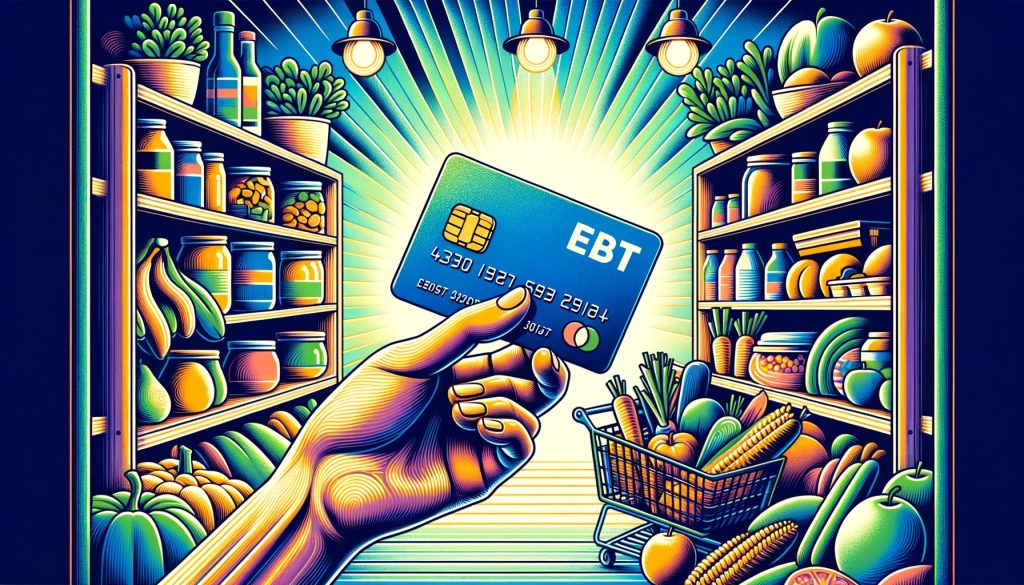
By Ethan Brooks November 21, 2024
In times of disaster, providing immediate relief and aid to affected individuals and communities is crucial. One essential tool that has revolutionized the way disaster relief is delivered is Electronic Benefit Transfer (EBT). EBT is a system that allows for the electronic distribution of benefits, such as food assistance, to eligible recipients.
This comprehensive article will delve into the importance of EBT in disaster relief and recovery efforts, exploring its basics, benefits, challenges, and solutions, as well as its role in ensuring food security during emergencies. By understanding the significance of EBT, we can better appreciate its role in facilitating efficient and effective disaster relief operations.
The Basics of EBT: Exploring Electronic Benefit Transfer Systems
To comprehend the importance of EBT in disaster relief, it is essential to understand the basics of the system. EBT is an electronic system that enables the distribution of benefits through a card-based system. Recipients are provided with an EBT card, similar to a debit card, which they can use to access their benefits. These benefits can include Supplemental Nutrition Assistance Program (SNAP) benefits, Temporary Assistance for Needy Families (TANF) benefits, and other forms of assistance.
EBT operates through a secure network that connects various stakeholders, including government agencies, financial institutions, and retailers. When a recipient makes a purchase using their EBT card, the transaction is processed in real-time, deducting the appropriate amount from their benefit balance. This system eliminates the need for paper vouchers or checks, streamlining the distribution process and reducing administrative costs.
EBT in Disaster Situations: How it Facilitates Relief Operations

During a disaster, traditional methods of distributing aid, such as physical vouchers or cash, can be inefficient and prone to abuse. EBT offers a more efficient and secure alternative, enabling relief organizations to quickly provide assistance to affected individuals and communities. By utilizing EBT, relief operations can be expedited, ensuring that aid reaches those in need promptly.
One of the key advantages of EBT in disaster situations is its ability to provide immediate access to funds. In the aftermath of a disaster, individuals may be displaced from their homes or face limited access to basic necessities. EBT allows for the rapid distribution of benefits, enabling recipients to purchase essential items such as food, water, and clothing. This immediate access to funds helps alleviate the immediate hardships faced by disaster victims.
Furthermore, EBT offers flexibility in terms of benefit usage. Unlike traditional methods that restrict the use of aid to specific items or locations, EBT allows recipients to purchase eligible items from authorized retailers. This flexibility ensures that individuals can obtain the items they need most urgently, adapting to their unique circumstances.
The Benefits of EBT in Disaster Relief: Efficiency, Accountability, and Flexibility
The utilization of EBT in disaster relief efforts brings forth numerous benefits that contribute to the overall efficiency and effectiveness of relief operations. One of the primary advantages is the increased efficiency in distributing aid. EBT eliminates the need for manual processing of paper vouchers or checks, reducing administrative burdens and allowing relief organizations to focus on delivering aid rather than paperwork. This streamlined process enables relief workers to reach more individuals and communities in a shorter amount of time.
Moreover, EBT enhances accountability in the distribution of benefits. The electronic nature of the system provides a transparent record of transactions, ensuring that funds are used for their intended purpose. This accountability minimizes the risk of fraud and misuse of relief funds, safeguarding the resources allocated for disaster relief.
Additionally, EBT offers flexibility in terms of benefit delivery. In disaster situations, traditional methods of aid distribution may be impractical or impossible due to logistical challenges. EBT allows for the remote distribution of benefits, enabling relief organizations to reach individuals in hard-to-reach areas or those who have been displaced. This flexibility ensures that aid can be provided to all affected individuals, regardless of their location or circumstances.
Implementing EBT in Disaster-Prone Areas: Challenges and Solutions

While EBT offers numerous benefits in disaster relief efforts, implementing the system in disaster-prone areas can present unique challenges. One of the primary challenges is the establishment of a reliable and secure network infrastructure. In areas prone to natural disasters, such as hurricanes or earthquakes, the existing communication and power infrastructure may be severely damaged or disrupted. To overcome this challenge, it is crucial to invest in robust network systems that can withstand such disasters and ensure uninterrupted access to EBT services.
Another challenge is ensuring the availability of EBT services during emergencies. In disaster situations, traditional banking and financial services may be inaccessible, making it difficult for recipients to access their benefits. To address this issue, alternative methods of benefit distribution, such as mobile EBT units or temporary distribution centers, can be established in disaster-prone areas. These measures ensure that individuals can access their benefits even in the absence of traditional banking services.
Furthermore, training and education play a vital role in the successful implementation of EBT in disaster-prone areas. It is essential to educate both relief workers and recipients on the proper use of EBT cards and the benefits available to them. This knowledge empowers individuals to make informed decisions and ensures that the system is utilized effectively.
EBT and Food Security: Ensuring Access to Nutritious Meals during Emergencies

In times of disaster, ensuring food security becomes a critical priority. EBT plays a crucial role in addressing this need by providing access to nutritious meals during emergencies. The system allows recipients to use their benefits to purchase eligible food items, ensuring that they have access to an adequate and balanced diet.
EBT offers several advantages in terms of food security during disasters. Firstly, it allows for the rapid distribution of benefits, enabling individuals to purchase food immediately after a disaster strikes. This immediate access to funds helps prevent food shortages and ensures that individuals have access to essential sustenance.
Secondly, EBT promotes choice and dignity in food selection. Unlike traditional methods that provide pre-packaged food boxes or limited options, EBT allows recipients to choose the food items that best suit their dietary needs and preferences. This choice empowers individuals and ensures that their nutritional requirements are met.
Lastly, EBT contributes to the local economy during disaster recovery. By allowing recipients to purchase food from authorized retailers, EBT supports local businesses and stimulates economic activity in affected areas. This economic boost helps communities recover and rebuild in the aftermath of a disaster.
EBT Fraud Prevention and Security Measures: Safeguarding Relief Funds
As with any system involving the distribution of funds, EBT is susceptible to fraud and misuse. However, robust fraud prevention and security measures are in place to safeguard relief funds and ensure that they reach those who truly need them.
One of the primary security measures is the use of Personal Identification Numbers (PINs) to access EBT benefits. Recipients are required to enter their unique PINs when making purchases, adding an additional layer of security to the system. This PIN-based authentication helps prevent unauthorized individuals from accessing and using EBT benefits.
Furthermore, EBT systems employ advanced encryption and security protocols to protect sensitive data. These measures ensure that personal and financial information remains secure and confidential, minimizing the risk of identity theft or fraud.
Additionally, regular monitoring and auditing of EBT transactions are conducted to detect and prevent fraudulent activities. Suspicious transactions or patterns are flagged for further investigation, allowing for timely intervention and prevention of fraud.
Frequently Asked Questions (FAQs)
Q1. What is EBT, and how does it work?
EBT stands for Electronic Benefit Transfer, which is a system that electronically distributes benefits, such as food assistance, to eligible recipients. Recipients are provided with an EBT card, similar to a debit card, which they can use to access their benefits. When a purchase is made, the transaction is processed in real-time, deducting the appropriate amount from the recipient’s benefit balance.
Q2. What benefits can be accessed through EBT?
EBT can be used to access various benefits, including Supplemental Nutrition Assistance Program (SNAP) benefits, Temporary Assistance for Needy Families (TANF) benefits, and other forms of assistance.
Q3. How does EBT facilitate relief operations in disaster situations?
EBT facilitates relief operations by providing immediate access to funds, allowing recipients to purchase essential items such as food, water, and clothing. The system also offers flexibility in benefit usage, enabling individuals to adapt to their unique circumstances.
Q4. How does EBT enhance efficiency and accountability in disaster relief?
EBT enhances efficiency by eliminating the need for manual processing of paper vouchers or checks, reducing administrative burdens. The electronic nature of the system also ensures transparency and accountability in the distribution of benefits, minimizing the risk of fraud and misuse of relief funds.
Q5. What challenges are faced in implementing EBT in disaster-prone areas?
Implementing EBT in disaster-prone areas can be challenging due to the establishment of reliable network infrastructure, ensuring the availability of EBT services during emergencies, and providing adequate training and education to stakeholders.
Q6. What is the difference between EBT and traditional paper-based methods of distributing benefits?
EBT replaces traditional paper-based methods, such as food stamps or vouchers, with a plastic card similar to a debit or credit card. It allows for the electronic distribution of government benefits, providing a more efficient and convenient method for recipients to access their benefits.
Q7. Can EBT be used for purchasing non-food items during disaster situations?
EBT can be used to purchase eligible items, which may include non-food items, depending on the specific program and guidelines in place during a disaster situation.
Q8. How does EBT support financial stability during the recovery process?
By providing electronic access to benefits, EBT allows recipients to manage their funds more effectively, ensuring that they can meet their immediate needs while also planning for the future. This financial stability is crucial for individuals and families as they navigate the challenges of rebuilding their lives and communities.
Conclusion
In conclusion, Electronic Benefit Transfer (EBT) plays a vital role in disaster relief and recovery efforts. The system offers numerous benefits, including efficiency, accountability, and flexibility, which contribute to the overall effectiveness of relief operations. By providing immediate access to funds and ensuring the availability of nutritious meals, EBT helps alleviate the immediate hardships faced by disaster victims.
However, implementing EBT in disaster-prone areas presents unique challenges that require robust solutions. Through the implementation of reliable network infrastructure, alternative distribution methods, and comprehensive training, the full potential of EBT can be harnessed in disaster relief efforts. By understanding the importance of EBT, we can continue to improve and enhance the delivery of aid during times of crisis, ensuring that affected individuals and communities receive the support they need to recover and rebuild.